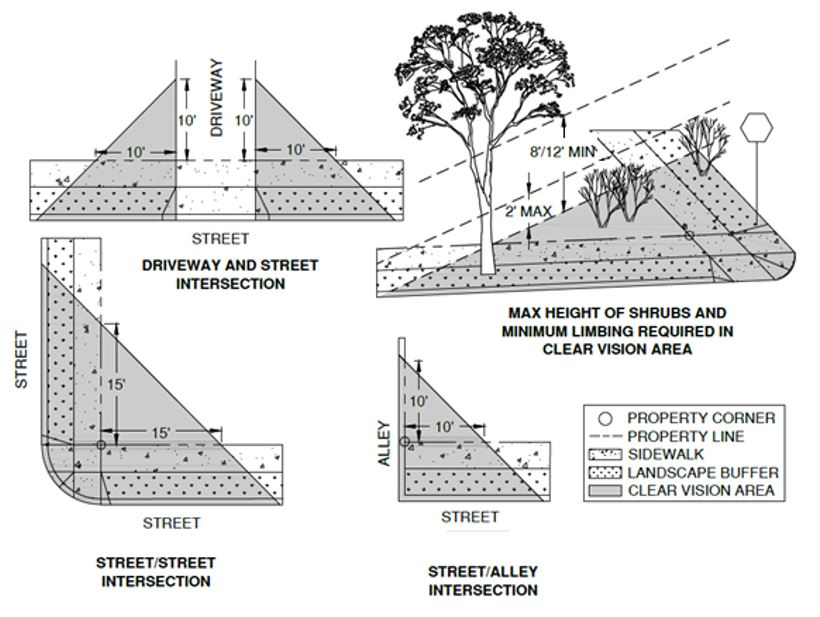3.1.500 Clear Vision Areas.
A. Purpose. Clear vision areas are established to ensure that obstructions do not infringe on the sight lines needed by motorists, pedestrians, bicyclists and others approaching potential conflict points at intersections.
B. Applicability. In all zones except the CB Zone, clear vision areas as described below and illustrated in Figure 3.1.500.A must be established at the intersection of two streets, an alley and a street, a driveway and a street or a street and a railroad right-of-way in order to provide adequate vision of conflicting traffic movements as well as street signs. These standards are applicable to public and private streets, alleys and mid-block lanes, and driveways.
C. The following standards apply to clear vision areas:
1. The clear vision area is in the shape of a triangle and extends across the corner of private property to the face of curb at the street or alley as shown in Figure 3.1.500.A. The two legs of the clear vision triangle are each measured from the point of intersection of the two corner lot lines, special setback lines, or access easement lines. Where lot lines have rounded corners, the lot lines are extended in a straight line to a point of intersection. Measurements along a driveway are taken at the edge of pavement.
Figure 3.1.500.A.

2. The following measurements define the clear vision areas:
|
Intersection at a Street and the following: |
Minimum Distance of Triangle Side |
|---|---|
|
Street |
15 feet |
|
Alley |
10 feet |
|
Driveway |
10 feet |
|
Railroad |
15 feet |
3. Unless exempted below, there must be no fence, wall, vehicular parking, sign, building, structure, or any other obstruction to vision within the clear vision area between the height of two feet and eight feet above the top of the curb. In cut sections, embankments must be graded to comply with these requirements. Shrubs or foliage must not exceed two feet in height. Existing trees must be limbed to a minimum of eight feet above the top of curb or 12 feet above adjacent bike lanes. New trees are not permitted within the clear vision area.
a. Exemptions.
i. Street sign, post or pole (e.g., power, signal, or luminaire pole).
ii. Any private post or pole eight inches or less in diameter (width or length).
4. Driveway approaches and driveways are not permitted within the clear vision area. On-street parking is not permitted within 20 feet of an accessible ramp or within 10 feet of a driveway approach.
5. Additional clear vision areas may be required as directed by the City Engineer.
D. The City Engineer may modify the clear vision area requirements upon written request by the applicant if, in the City Engineer’s determination, the construction within this triangle will not adversely impact traffic or pedestrian safety. Reasons for the modification(s) are limited to special circumstances such as the existence of available right-of-way in excess of City standards, curb extensions, or unique traffic flow (one way). [Ord. NS-2303, 2018; Ord. NS-2177, 2012; Ord. NS-2016, 2006]